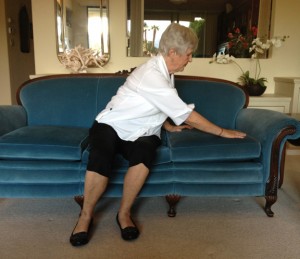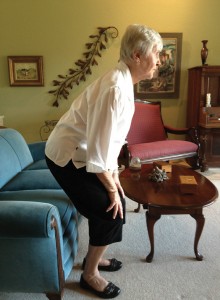
Trunk rotations in the morning help loosen stiff bodies
We know the value of common exercise like walking, running, swimming, tennis, golf, soccer, etc. But these simple activities are often out of reach for those living with Parkinson’s. However, there are other exercises, not as strenuous, which can be valuable tools to improve a Parkinson’s patient’s activities of daily living (or ADLs).
With Parkinson’s, the body is often stiff and slow moving in the morning. To first loosen up, try a trunk rotation while sitting on the bed. Turn to one side and reach across your body with the opposite hand. Move as much as you can without pain and hold it for a few seconds. Repeat on other side, and as often as comfortable each time you do the exercise.

Chair squats improve balance and strengthen muscles
Chair exercises can typically be a difficult task for anyone, and especially someone with Parkinson’s. This may require assistance from a spouse or caregiver. To lessen the difficulty, slide forward to the edge of the chair. If still difficult, remind the person to “push back with your shoulders and scoot your bottom forward” to get in proper position. Then lean forward far enough to un-weight the bottom. Frequently, people use cues for “nose over toes.” This allows someone to move his body weight forward and propel themselves up from the chair. If unable to do this independently, the caregiver and person can learn to move together to reduce the strain on the assistant. When sitting down, make sure to bend forward from the hips (sticking your bottom out behind you) to control seating motion.
Parkinson’s patients often have difficulty initiating gait – they “can’t get started.” This simple exercise may help. Stand with one foot slightly in front of the other, with weight equally balanced. Then shift weight on to the front foot and then the back (in a rocking motion). After a few such rocking motions, give the instruction to “start” to initiate walking. The patient may find this works better with left rather than right forward, or vice versa. Experiment to see if one foot is more effective. This technique can be used in public without drawing attention.

Rocking exercises can help initiate forward gait
Opening a door is often problematic for Parkinson’s patients, because of the need to back up. This movement can safely be practiced by holding on to the kitchen counter while moving slowly backward. As this becomes easier, the steps can become bigger. Go slowly and in a controlled manner to avoid loss of balance.
While results are slow, research has shown that repetitive exercises done regularly and with as much force as possible can be very effective in the relearning /retraining process for Parkinson’s. While the patient may continue to need assistance, they and their caregiver can work together to minimize the strain on them both. This results in success for the patient, caregiver and family.
These are simple exercises that anyone can practice safely. If needed, consult with your physician and ask for a referral to a physical therapist to initiate an individualized assessment and treatment program.
Dixie Brubaker is a physical therapist with New Beginnings Physical Therapy, Inc., an in-home therapy company and can be reached at 760-218-9961 or online at NewBeginningPT.com.
















































Comments (0)